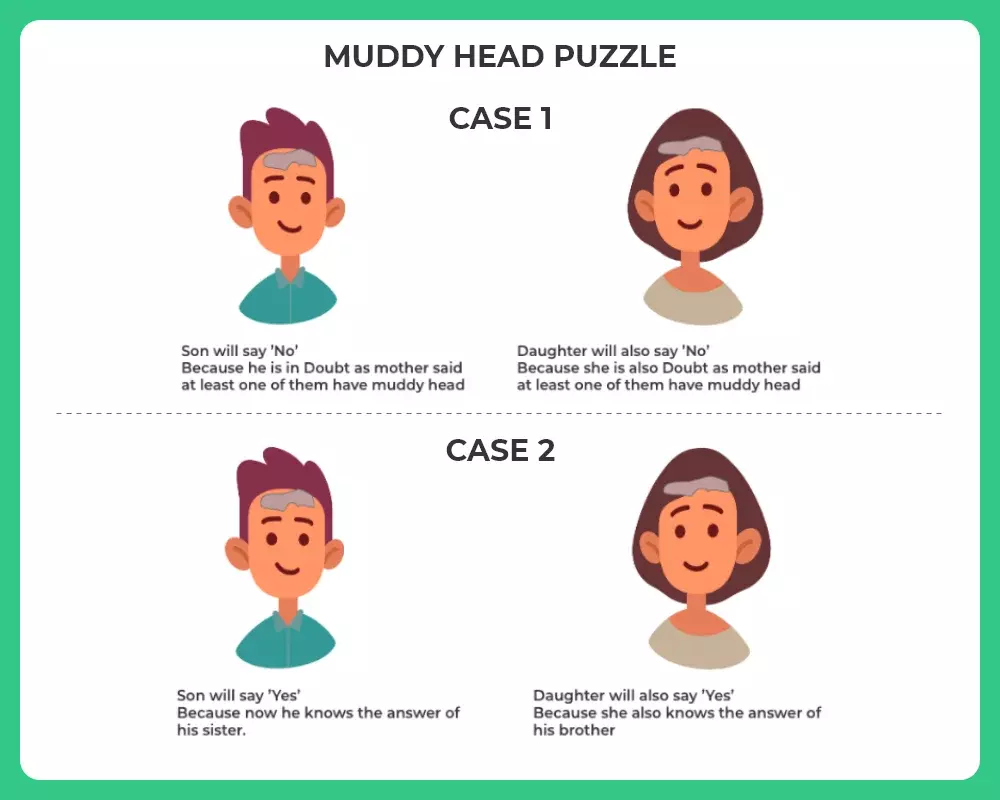Muddy Head Puzzle
Solution

Here we have the solution for the Muddy Head Puzzle:-
- Let S be the statement that the son has a muddy forehead and let D be the statement that the daughter has a muddy forehead.
- When the mother says that at least one of the two children has a muddy forehead, she is stating that the disjunction S ∨ D is true.
- Both children will answer “No” the first time the question is asked because each sees mud on the other child’s forehead.
- That is, the son knows that D is true but does not know whether S is true, and the daughter knows that S is true, but does not know whether D is true.
- After the son has answered “No” to the first question, the daughter can determine that D must be true. This follows because when the first question is asked, the son knows that S ∨ D is true, but cannot determine whether S is true.
- Using this information, the daughter can conclude that D must be true, for if D were false, the son could have reasoned that because S ∨ D is true, then S must be true, and he would have answered “Yes” to the first question.
- The son can reason similarly to determine that S must be true. It follows that both children answer “Yes” the second time the question is asked.
Muddy Head
In Muddy Head Puzzle, a mother tells her son and daughter, to play without getting dirty. However, while playing, both children get mud on their foreheads. The mother says “At least one of you has a muddy forehead”. She then asks the children to answer “Yes” or “No” to the question: “Do you know whether you have a muddy forehead?” The mother asks this question twice. What will the children answer each time this question is asked, assuming that a child can see whether his/her sibling has a muddy forehead, but cannot see his or her forehead?
- Assume that both children are honest and that the children answer each question simultaneously.

Here we have the solution for the Muddy Head Puzzle:-
- Let S be the statement that the son has a muddy forehead and let D be the statement that the daughter has a muddy forehead.
- When the mother says that at least one of the two children has a muddy forehead, she is stating that the disjunction S ∨ D is true.
- Both children will answer “No” the first time the question is asked because each sees mud on the other child’s forehead.
- That is, the son knows that D is true but does not know whether S is true, and the daughter knows that S is true, but does not know whether D is true.
- After the son has answered “No” to the first question, the daughter can determine that D must be true. This follows because when the first question is asked, the son knows that S ∨ D is true, but cannot determine whether S is true.
- Using this information, the daughter can conclude that D must be true, for if D were false, the son could have reasoned that because S ∨ D is true, then S must be true, and he would have answered “Yes” to the first question.
- The son can reason similarly to determine that S must be true. It follows that both children answer “Yes” the second time the question is asked.
Prime Course Trailer
Related Banners
Get PrepInsta Prime & get Access to all 200+ courses offered by PrepInsta in One Subscription
Get over 200+ course One Subscription
Courses like AI/ML, Cloud Computing, Ethical Hacking, C, C++, Java, Python, DSA (All Languages), Competitive Coding (All Languages), TCS, Infosys, Wipro, Amazon, DBMS, SQL and others
- Maximum Runs in cricket Answer
- Siblings in a family Answer
- Days of month using a dice Answer
- Sand Timer Answer
- 2 Player and coin Answer
- Birbal a fruits traderAnswer
- Where she lives Answer
- Life and Luck Answer
- Flip the card Answer
- Analog clockAnswer
- The Adventurer’s Answer
- Train Station Answer
- Pick a stick Puzzle Answer






Login/Signup to comment